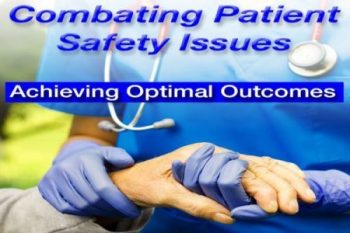Nurses can help achieve optimal outcomes.
The COVID-19 pandemic brought supply chain issues to the forefront, as hospitals and other healthcare settings struggled to provide sufficient personal protective equipment to staff. But even before recent events, hospitals, especially operating rooms (ORs), have long struggled to address supply chain challenges to reduce costs and improve efficiency. Having the right supplies at the right time for the right patient is an essential part of delivering optimal patient care, but too often, this ideal isn’t met. It’s up to nurses, in their role as patient advocates, to understand the effects of and reasons for supply chain problems and to take a leading role in addressing them.
American Nurse Journal recently spoke about these issues with two perioperative nurses at Good Samaritan Medical Center in West Palm Beach, Florida. Deena Carney, BSN, RN, MHA, CNOR, is director of surgical services, and Heather Salvatore, BSN, RN, CNOR, is the robotics coordinator. Good Samaritan has 12 ORs and performs about 5,700 cases a year.
Effects of supply chain issues
Supply chain issues affect patients, frontline nurses, nurse leaders, and organizations. Patients may experience harm when the right equipment isn’t available at the right time, forcing nurses to leave the room to track down supplies. “Anything can change in the blink of an eye,” Salvatore says about this patient safety issue. “You never know when the surgeon or anesthesiologist might need something or something could go wrong.”
Frontline nurses experience stress when they don’t have the supplies they need and are on the receiving end of surgeons’ dissatisfaction. Salvatore cites a recent example of having four cases of the same procedure, each with different supplies. “It gets very frustrating,” she says. Carney notes that because so much of the OR is technologically advanced, it’s difficult for staff to understand why basic inventory can’t be accurate.
Nurse leaders can lose staff (a recent survey of nurses by Syft found that 18% have considered leaving their current role due to supply chain problems) and see negative budget variances as a result of staff turnover and lost revenue because supplies aren’t documented. In addition, not having the right supplies can result in case delays. Balancing the need for sufficient supplies on hand and the costs of overstocking can be challenging. “You don’t want too much inventory on the shelf, but you want to have what you need,” Carney says.
Organizations lose revenue when supplies aren’t documented and unnecessary supplies are opened but can’t be billed to patients; organizations also suffer from staff turnover costs.
Sources of supply chain issues
Causes of supply chain issues include outdated surgeon preference cards; lack of technology to facilitate automated replenishment; cumbersome documentation requirements (such as poor electronic healthcare record [EHR] interfaces); and, most importantly, lack of input from frontline nurses about their ideas for improving processes and when decisions are made about products and workflow.
Carney and Salvatore have seen some of these issues at Good Samaritan. “The biggest supply chain challenge is having the right supplies in the OR,” Carney says. For example, outdated surgeon preference cards can lead to staff gathering the wrong supplies for a case. Another problem arises when products are replaced because of cost considerations, but the OR staff isn’t notified.
What nurses can do
Frontline nurses and nurse leaders can play a role in addressing supply chain issues. Carney and Salvatore provide several strategies.
Update preference cards regularly. “I update cards on a regular basis so they’re as close to 100% accurate as possible,” Salvatore says, adding that involving surgeons in this process is key. Accurate cards help avoid opening unnecessary supplies.
Communicate. Carney and Salvatore emphasize the need to have regular, open communication among frontline staff, those who supply the OR, and others involved in the supply chain process.
It’s also important to consider communications barriers such as terminology differences between the OR and materials management. For example, Salvatore says, “I will say I need a 24-French J tube, but materials management knows it as 6270P.”
“It’s like we’re in the same country but speaking two different languages,” Salvatore says. OR and materials management staff need to collaborate to bridge language differences.
Document accurately. At Good Samaritan, documentation in the OR via the EHR is used to charge patients and for replenishing inventory. However, it all depends on frontline nurses entering the correct information. Items on the card are in the EHR, but it’s up to the nurse to ensure that what was actually used is reflected in the documentation.
In addition, it’s important to have a system to capture supplies that are opened but not used (and, therefore, not billed to the patient) but still need to be replaced.
Use technology. Technology is an effective tool for ensuring an adequate supply chain because it removes some of the natural human error that can occur with manual methods. “When someone removes an item on a shelf, you’re relying on them to also accurately count what’s left in the bin and note if something needs to be replenished,” Carney says. “It’s a tedious manual system.”
That’s why she’s working with a team to evaluate technology such as RFID (radio-frequency identification) and barcode scanners, smart bins (that detect when stock levels are low), and other strategies such as better integration of the EHR with the inventory system to automate the supply chain process. “You need to have a true automated tracking and inventory system,” Carney says. “Walmart, Target, and Costco all have that, and hospitals need that too.”
Examples of how technology can help improve both inventory and workflow include automated alerts for supply replenishing, automated documentation, future need forecasting (through data analytics), and automatically updated preference cards. In the Syft survey (tinyurl.com/2sad3x8w), OR nurses noted that technology in the form of automation tools, more accurate physician preference cards, and more streamlined workflows would help improve supply chain processes in their hospitals.
Take a team approach. Good Samaritan created a team to address supply chain issues. Carney says that nurses on the team are essential for providing that frontline perspective. “You have to involve the end user,” she notes. “It can’t be left up to administrators.”
Committees within the team work on specific tasks. Members vary by committee purpose but might include materials management staff and leaders, OR staff and leaders, surgical aids, environmental services staff, and surgical technologists (STs). STs play a key role in what is opened. For example, they may ask for extra supplies “just in case” they are needed but that aren’t essential for the procedure.
Speak up. Frontline nurses can make suggestions for improvements to leaders and serve on committees related to supply chain issues, such as those evaluating technology.
“Everybody who’s working within surgical services needs to be aware of and needs to be part of supply chain discussions,” Salvatore says, adding that nurses’ responsibility to patients goes beyond physical care to include ensuring supplies are used appropriately so patients’ bills aren’t higher than necessary.
Call to action
Failing to ensure an effective supply chain can have a negative effect on patients, nurses, and organizations. By speaking up and collaborating with supply chain managers in teams, nurses can make change to benefit themselves and their patients. “We are the patient’s advocate on every possible level,” Carney says.


















